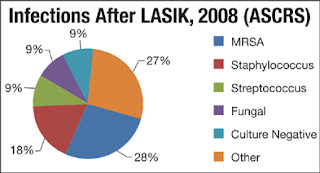Corneal infections are, although not frequent, a major
concern after laser in situ keratomileusis (LASIK) and surface ablation (SA)
techniques (PRK, LASEK and epi-LASIK).
The real prevalence of infectious keratitis after refractive
surgery is difficult to determine, due to its rarity. In 2010 we reported a
prevalence of 72 cases in 204,586 LASIK procedures, a 0.035%. Other series had
shown prevalences ranging from 0.034 to 0.180%, but ours was, by far, the
largest series published to date. As happens in LASIK, the prevalence of
infections after SA is rare and it is difficult to determine if the series does
not comprise a large number of operated eyes. In 2011 we published our
prevalence in SA. We found 39 cases in 18,651 procedures, a 0.200%. Therefore,
in our institution, corneal infections were five times more prevalent after SAthan after LASIK.
There is much consensus about the standard treatment of
corneal infections after corneal refractive surgery. According to the ASCRS
White Paper aggressive management with early flap lifting, scraping, culture,
and irrigation with antibiotics should be followed. When the infection has an
early onset (less than 15 days) moxifloxacin 0.5% (or gatifloxacin 0.3%) is
recommended along with cefazolin 50 mg/ml every 30 minutes. If it has a late
onset (more than 15 days) moxifloxacin 0.5% (or gatifloxacin 0.3%) must be
alternated with amikacin 35 mg/ml. In every case, oral doxicyclin is to be
administered (100 mg, twice a day).

No comments:
Post a Comment